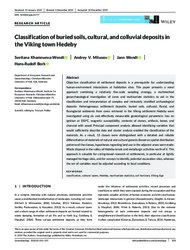Classification of buried soils, cultural, and colluvial deposits in the Viking town Hedeby
DOI: https://doi.org/10.1002/gea.21777
Persistent URL: http://resolver.sub.uni-goettingen.de/purl?gldocs-11858/9444
Persistent URL: http://resolver.sub.uni-goettingen.de/purl?gldocs-11858/9444
Khamnueva-Wendt, Svetlana; Mitusov, Andrey V.; Wendt, Jann; Bork, Hans-Rudolf, 2019: Classification of buried soils, cultural, and colluvial deposits in the Viking town Hedeby. In: Geoarchaeology, Band 35, 3: 313 - 337, DOI: 10.1002/gea.21777.
 |
Dokument öffnen: |
Objective classification of settlement deposits is a prerequisite for understanding human-environment interactions at habitation sites. This paper presents a novel approach combining a relatively fine-scale sampling strategy, a multimethod geoarchaeological investigation of cores and multivariate statistics to aid in the classification and interpretation of complex and intricately stratified archaeological deposits. Heterogeneous settlement deposits, buried soils, colluvial, fluvial, and fluvioglacial sediments from cores retrieved in the Viking settlement Hedeby were investigated using six cost-effectively measurable geoecological parameters: loss on ignition at 550°C, magnetic susceptibility, contents of stones, artifacts, bones, and charcoal with wood. Principal component analysis allowed identifying variables that would sufficiently describe data and cluster analysis enabled the classification of the materials. As a result, 13 classes were distinguished with a detailed and reliable differentiation of materials of natural and cultural genesis. Based on spatial distribution patterns of the classes, hypotheses regarding land use in the adjacent areas were made: Waste disposal in the valley of Hedeby-brook and metallurgic activities north of it. This approach is valuable for coring-based research at settlements, in particular at tightly managed heritage sites, and for surveys to identify potential excavation sites, whereas the set of variables must be adjusted according to local conditions.
Statistik:
ZugriffsstatistikSammlung:
This is an open access article under the terms of the Creative Commons Attribution-NonCommercial License, which permits use, distribution and reproduction in any medium, provided the original work is properly cited and is not used for commercial purposes.

